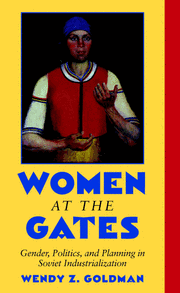Book contents
- Frontmatter
- Contents
- Acknowledgments
- List of Illustrations
- List of Tables
- Acronyms and Abbreviations
- Women at the Gates
- Introduction
- 1 Guarding the Gates to the Working Class: Women in Industry, 1917–1929
- 2 The Struggle over Working-Class Feminism
- 3 The Gates Come Tumbling Down
- 4 From Exclusion to Recruitment
- 5 “The Five-Year Plan for Women”: Planning Above, Counterplanning Below
- 6 Planning and Chaos: The Struggle for Control
- 7 Gender Relations in Industry: Voices from the Point of Production
- 8 Rebuilding the Gates to the Working Class
- Conclusion
- Index
- Plate Section
3 - The Gates Come Tumbling Down
Published online by Cambridge University Press: 30 July 2009
- Frontmatter
- Contents
- Acknowledgments
- List of Illustrations
- List of Tables
- Acronyms and Abbreviations
- Women at the Gates
- Introduction
- 1 Guarding the Gates to the Working Class: Women in Industry, 1917–1929
- 2 The Struggle over Working-Class Feminism
- 3 The Gates Come Tumbling Down
- 4 From Exclusion to Recruitment
- 5 “The Five-Year Plan for Women”: Planning Above, Counterplanning Below
- 6 Planning and Chaos: The Struggle for Control
- 7 Gender Relations in Industry: Voices from the Point of Production
- 8 Rebuilding the Gates to the Working Class
- Conclusion
- Index
- Plate Section
Summary
Millions of women – wives and family members of workers and employees, servants, women in handicrafts and artels, landless women, poor peasants, collective farmers, eastern tribal women – this entire mass, once occupied with exhausting and dulling household labor, is now joining the great socialist construction of the country.
B. Marsheva, labor analyst, 1931The composition of the new working class takes its shape in large measure from unused reserves in the working-class family.
Report on female labor, 1932In the spring of 1929, the Party adopted the first five-year plan. The plan, taking up three volumes and more than two thousand pages, allocated 64.5 billion rubles to investment, 78 percent of which was targeted for heavy industry and 50 percent for new construction. Adoption of the plan, in the words of one economist, was “tantamount to turning the country into a vast construction site.” After a decade of unemployment and exclusion, the gates to the working class came tumbling down. Almost 2.3 million people entered the waged labor force in 1930, followed by 6.3 million more in 1931. Party leaders, labor officials, and planners critically noted at the time that this mass influx of new workers occurred “samotek,” or independent of any state plan or policy. The building of huge new industrial complexes and hydroelectric stations such as Magnitostroi, Kuznetsstroi, and Dneprostroi drew thousands of workers. Hungry town dwellers and dispossessed peasants massed at new construction sites and factory gates in search of work.
- Type
- Chapter
- Information
- Women at the GatesGender and Industry in Stalin's Russia, pp. 70 - 108Publisher: Cambridge University PressPrint publication year: 2002



